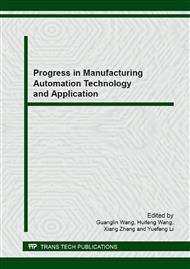p.253
p.259
p.265
p.270
p.276
p.283
p.289
p.295
p.300
Research on Technologies of Augmented Reality for CNC Machining Process Simulation
Abstract:
Based on Virtual Numerical Control machining system (VNC), a new method of Augmented Numerical Control machining system (ANC) which aims at the realization of NC machining process simulation in real machining environment is put forward. The System inputs continuous video images of real NC processing environment through camera to identify and locate the major machining and positioning parts of real machine in the image stream. And the virtual parts of VNC will be matched to the corresponding real ones of real machining system to achieve the registration of ANC. The NC system drives the virtual machining models for processing through a real machine. On the other hand, the actual running information of CNC machine are imported into the ANC system to drive some models of process variables such as cutting force, material removal rate, chip shape, tool temperature, cutting tool wear. ANC provides the platform to integrate the geometry and physical simulation based on actual information from real CNC machining environment.
Info:
Periodical:
Pages:
276-282
Citation:
Online since:
September 2013
Authors:
Keywords:
Price:
Сopyright:
© 2014 Trans Tech Publications Ltd. All Rights Reserved
Share:
Citation:


